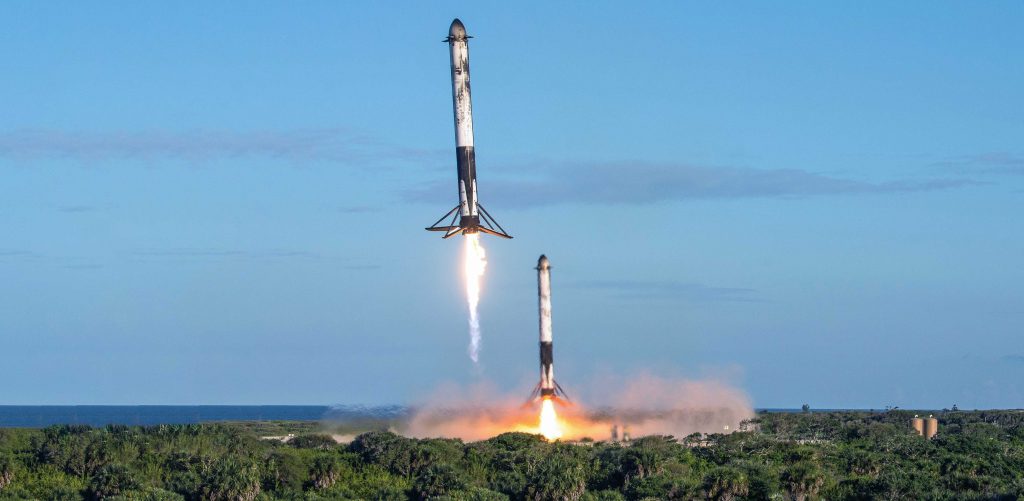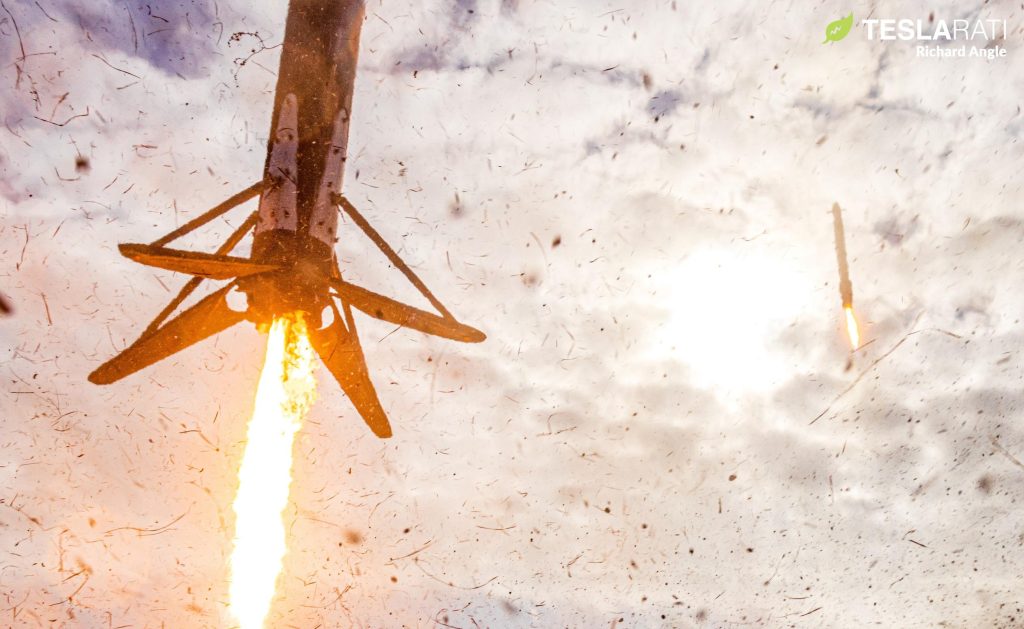

News
SpaceX’s next Falcon Heavy rocket on track for early 2023 launch
Two weeks after SpaceX’s first Falcon Heavy launch in three and a half years, the US Space Force says that the rocket is on track to launch again “early next year.”
Immediately before and after Falcon Heavy’s first operational launch for the US Space Force, the Space Systems Command confirmed that the massive SpaceX rocket’s next military launch – USSF-67 – was scheduled no earlier than January 2023. The military also confirmed that USSF-67 would reuse two of the three Falcon Heavy boosters that helped launch USSF-44 on November 1st.
Two weeks later, the US Space Force’s tone hasn’t changed, and the Space Systems Command remains confident that Falcon Heavy is on track to launch USSF-67 less than three months after USSF-44.
Assuming the lack of a schedule change is intentional rather than a matter of not checking with SpaceX or other US stakeholders, no change is a good sign. Since the last time the SSC reported that USSF-67 was on track to launch in January 2023, SpaceX successfully launched its fourth Falcon Heavy rocket. USSF-44 was the company’s first launch directly into a geosynchronous orbit ~36,000 kilometers (~22,300 mi) above Earth’s surface.
SpaceX successfully recovered both of Falcon Heavy’s ‘side cores’ and has likely had enough time to thoroughly inspect each booster and begin the refurbishment process. If data gathered from the launch, landing, or recovered boosters uncovered issues with Falcon Heavy’s performance during USSF-44, USSF-67 would almost certainly be delayed. The chances of a delay are magnified by the fact that USSF-67 can’t launch until two of USSF-44’s Falcon Heavy boosters are refurbished and declared ready for a second flight.
But it appears that even a gap of 40 months between Falcon Heavy launches wasn’t enough to make SpaceX falter – at least after working out some prelaunch kinks. SpaceX accomplished a similar feat – launching two Falcon Heavy rockets in less than three months with one pair of side boosters – on the rocket’s second and third launches in April and June 2019. The mission that reused Flight 2’s side boosters was for the US Air Force, so SpaceX and the military already have direct experience tackling those challenges.
In the three and a half years since, SpaceX has gained a huge amount of experience recovering and refurbishing Falcon 9 Block 5 boosters and slashed its record turnaround (the time between two launches of the same booster) from 74 days to 21 days. SpaceX should thus have no issue turning Falcon Heavy side boosters B1064 and B1065 around for a second launch in January 2023, around 60 to 91 after their debut.


While preparing one Falcon Heavy rocket to launch USSF-67 in January, SpaceX – at least according to customer ViaSat – may also be preparing another Falcon Heavy rocket to launch the first ViaSat-3 satellite the same month. Unlike the US Space Force, which recently shipped [PDF] one of USSF-67’s payloads to Florida, ViaSat has yet to ship its first next-generation satellite to the launch site and says that milestone is scheduled for December 2022. That makes a February or March launch much more likely, but ViaSat recently told shareholders that ViaSat-3 remains on track to launch “in the earliest part of” Q1 2023.
Combined, USSF-67 and ViaSat-3 are scheduled to reuse Falcon Heavy side boosters B1064, B1065, B1052, and B1053. Each will use a brand new center core: B1068 for ViaSat-3 and B1079 for USSF-67, according to Next Spaceflight. Like USSF-44, which was the first time SpaceX intentionally expended a Falcon Heavy booster, both new center cores are expected to be expended.
For several reasons, assembling and preparing Falcon Heavy for launch is significantly more time-consuming than Falcon 9, so there will likely be at least a two, three, or even four-week gap between Falcon Heavy’s next two launches. But as long as USSF-67 and ViaSat-3 are ready to fly during narrow windows in early and late January, it appears that SpaceX could launch two Falcon Heavy rockets in one calendar month.
SpaceX has as many as five Falcon Heavy launches scheduled in 2023 – a stark change after more than three years without a single flight.

News
Tesla (TSLA) receives “Buy” rating and $551 PT from Canaccord Genuity
He also maintained a “Buy” rating for TSLA stock over the company’s improving long-term outlook, which is driven by autonomy and robotics.

Canaccord Genuity analyst George Gianarikas raised his Tesla (NASDAQ:TSLA) price target from $482 to $551. He also maintained a “Buy” rating for TSLA stock over the company’s improving long-term outlook, which is driven by autonomy and robotics.
The analyst’s updated note
Gianarikas lowered his 4Q25 delivery estimates but pointed to several positive factors in the Tesla story. He noted that EV adoption in emerging markets is gaining pace, and progress in FSD and the Robotaxi rollout in 2026 represent major upside drivers. Further progress in the Optimus program next year could also add more momentum for the electric vehicle maker.
“Overall, yes, 4Q25 delivery expectations are being revised lower. However, the reset in the US EV market is laying the groundwork for a more durable and attractive long-term demand environment.
“At the same time, EV penetration in emerging markets is accelerating, reinforcing Tesla’s potential multi‑year growth runway beyond the US. Global progress in FSD and the anticipated rollout of a larger robotaxi fleet in 2026 are increasingly important components of the Tesla equity story and could provide sentiment tailwinds,” the analyst wrote.
Tesla’s busy 2026
The upcoming year would be a busy one for Tesla, considering the company’s plans and targets. The autonomous two-seat Cybercab has been confirmed to start production sometime in Q2 2026, as per Elon Musk during the 2025 Annual Shareholder Meeting.
Apart from this, Tesla is also expected to unveil the next-generation Roadster on April 1, 2026. Tesla is also expected to start high-volume production of the Tesla Semi in Nevada next year.
Apart from vehicle launches, Tesla has expressed its intentions to significantly ramp the rollout of FSD to several regions worldwide, such as Europe. Plans are also underway to launch more Robotaxi networks in several more key areas across the United States.
News
Waymo sues Santa Monica over order to halt overnight charging sessions
In its complaint, Waymo argued that its self-driving cars’ operations do not constitute a public nuisance, and compliance with the city’s order would cause the company irreparable harm.

Waymo has filed a lawsuit against the City of Santa Monica in Los Angeles County Superior Court, seeking to block an order that requires the company to cease overnight charging at two facilities.
In its complaint, Waymo argued that its self-driving cars’ operations do not constitute a public nuisance, and compliance with the city’s order would cause the company irreparable harm.
Nuisance claims
As noted in a report from the Los Angeles Times, Waymo’s two charging sites at Euclid Street and Broadway have operated for about a year, supporting the company’s growing fleet with round-the-clock activity. Unfortunately, this has also resulted in residents in the area reportedly being unable to sleep due to incessant beeping from self-driving taxis that are moving in and out of the charging stations around the clock.
Frustrated residents have protested against the Waymos by blocking the vehicles’ paths, placing cones, and “stacking” cars to create backups. This has also resulted in multiple calls to the police.
Last month, the city issued an order to Waymo and its charging partner, Voltera, to cease overnight operations at the charging locations, stating that the self-driving vehicles’ activities at night were a public nuisance. A December 15 meeting yielded no agreement on mitigations like software rerouting. Waymo proposed changes, but the city reportedly insisted that nothing would satisfy the irate residents.
“We are disappointed that the City has chosen an adversarial path over a collaborative one. The City’s position has been to insist that no actions taken or proposed by Waymo would satisfy the complaining neighbors and therefore must be deemed insufficient,” a Waymo spokesperson stated.
Waymo pushes back
In its legal complaint, Waymo stated that its “activities at the Broadway Facilities do not constitute a public nuisance.” The company also noted that it “faces imminent and irreparable harm to its operations, employees, and customers” from the city’s order. The suit also stated that the city was fully aware that the Voltera charging sites would be operating around the clock to support Waymo’s self-driving taxis.
The company highlighted over one million trips in Santa Monica since launch, with more than 50,000 rides starting or ending there in November alone. Waymo also criticized the city for adopting a contentious strategy against businesses.
“The City of Santa Monica’s recent actions are inconsistent with its stated goal of attracting investment. At a time when the City faces a serious fiscal crisis, officials are choosing to obstruct properly permitted investment rather than fostering a ‘ready for business’ environment,” Waymo stated.
News
Tesla FSD v14.2.2 is getting rave reviews from drivers
So far, early testers have reported buttery-smooth drives with confident performance, even at night or on twisty roads.

Tesla Full Self-Driving (Supervised) v14.2.2 is receiving positive reviews from owners, with several drivers praising the build’s lack of hesitation during lane changes and its smoother decision-making, among others.
The update, which started rolling out on Monday, also adds features like dynamic arrival pin adjustment. So far, early testers have reported buttery-smooth drives with confident performance, even at night or on twisty roads.
Owners highlight major improvements
Longtime Tesla owner and FSD user @BLKMDL3 shared a detailed 10-hour impression of FSD v14.2.2, noting that the system exhibited “zero lane change hesitation” and “extremely refined” lane choices. He praised Mad Max mode’s performance, stellar parking in locations including ticket dispensers, and impressive canyon runs even in dark conditions.
Fellow FSD user Dan Burkland reported an hour of FSD v14.2.2’s nighttime driving with “zero hesitations” and “buttery smooth” confidence reminiscent of Robotaxi rides in areas such as Austin, Texas. Veteran FSD user Whole Mars Catalog also demonstrated voice navigation via Grok, while Tesla owner Devin Olsen completed a nearly two-hour drive with FSD v14.2.2 in heavy traffic and rain with strong performance.
Closer to unsupervised
FSD has been receiving rave reviews, even from Tesla’s competitors. Xpeng CEO He Xiaopeng, for one, offered fresh praise for FSD v14.2 after visiting Silicon Valley. Following extended test drives of Tesla vehicles running the latest FSD software, He stated that the system has made major strides, reinforcing his view that Tesla’s approach to autonomy is indeed the proper path towards autonomy.
According to He, Tesla’s FSD has evolved from a smooth Level 2 advanced driver assistance system into what he described as a “near-Level 4” experience in terms of capabilities. While acknowledging that areas of improvement are still present, the Xpeng CEO stated that FSD’s current iteration significantly surpasses last year’s capabilities. He also reiterated his belief that Tesla’s strategy of using the same autonomous software and hardware architecture across private vehicles and robotaxis is the right long-term approach, as it would allow users to bypass intermediate autonomy stages and move closer to Level 4 functionality.








